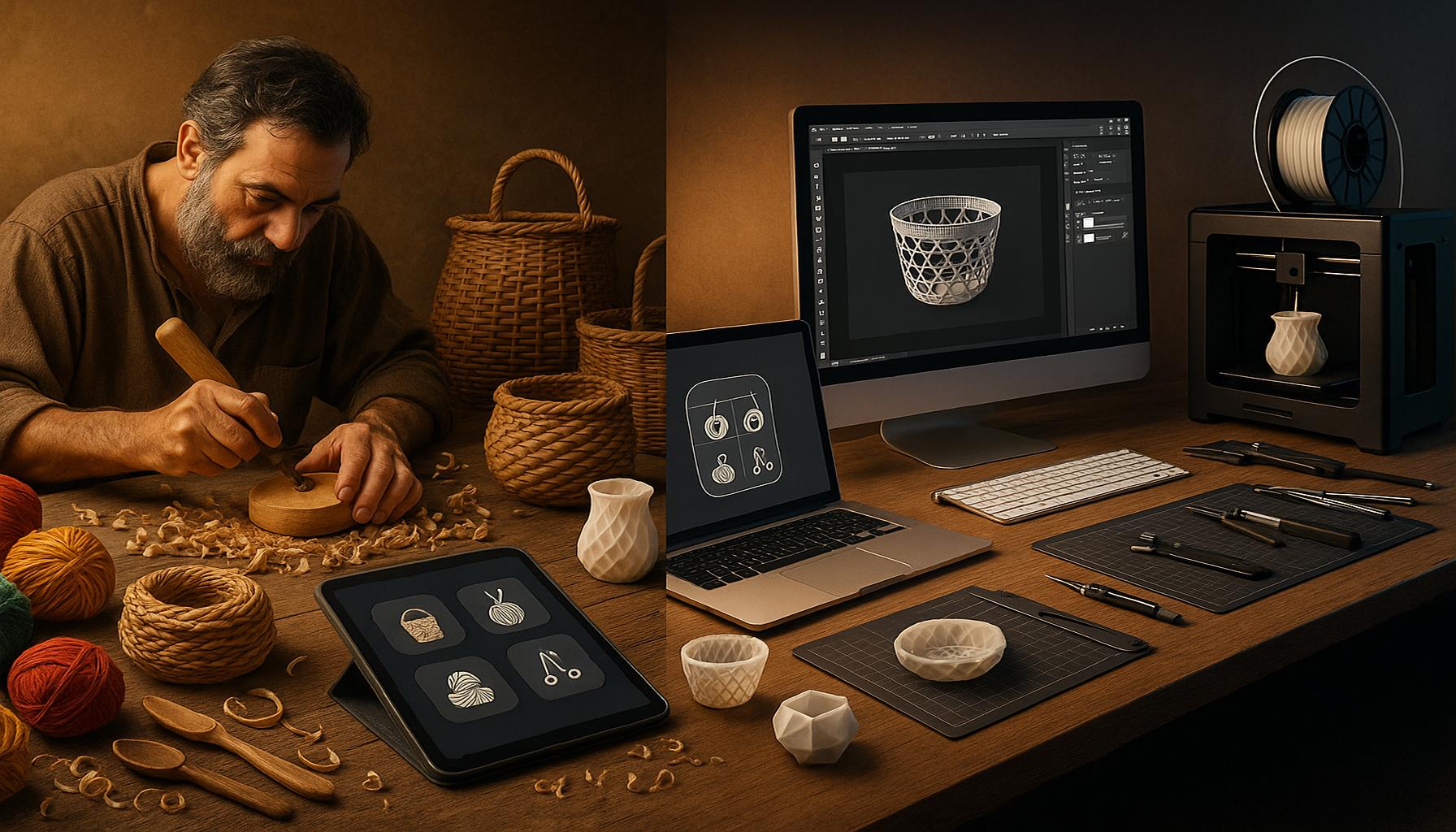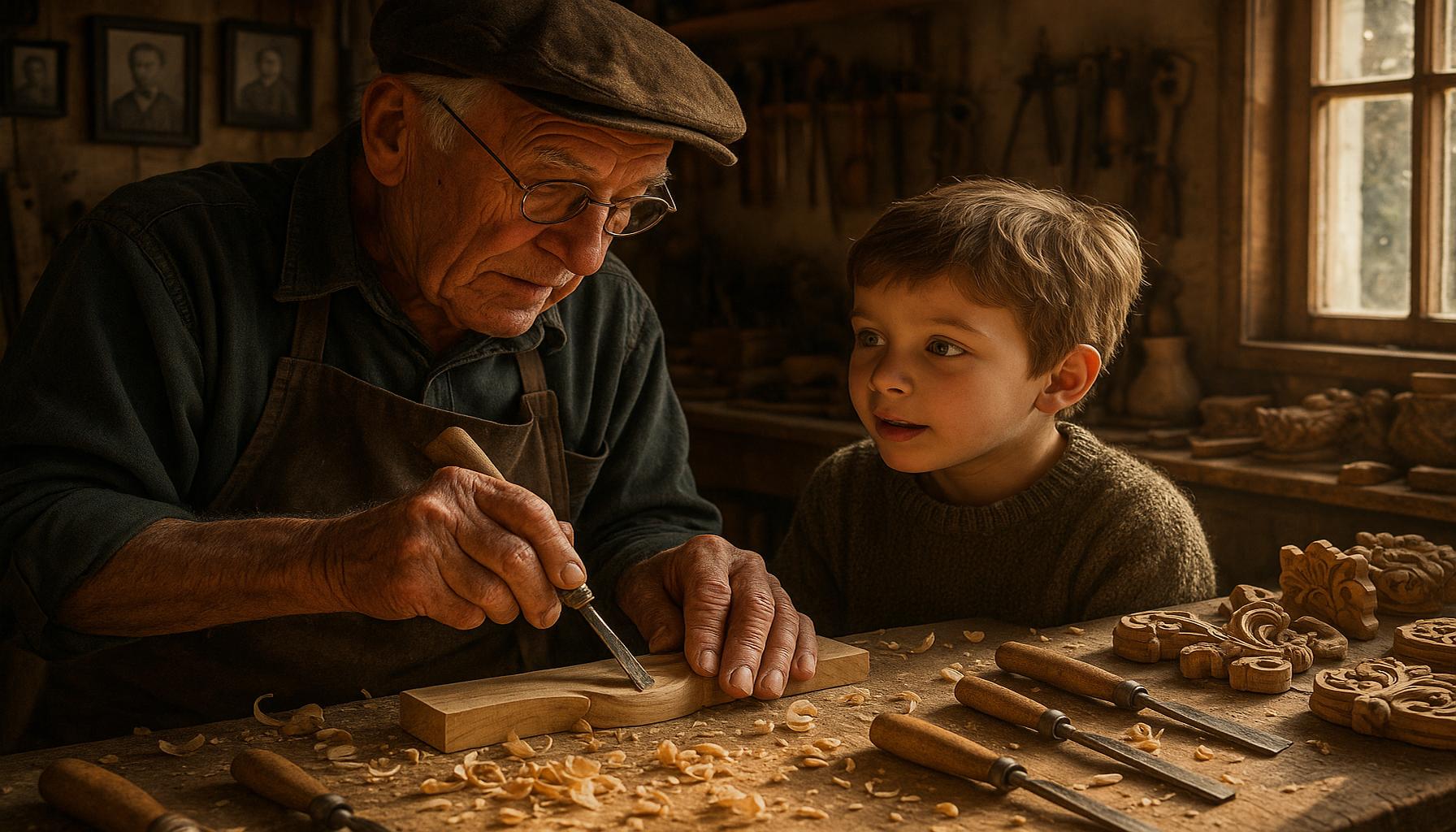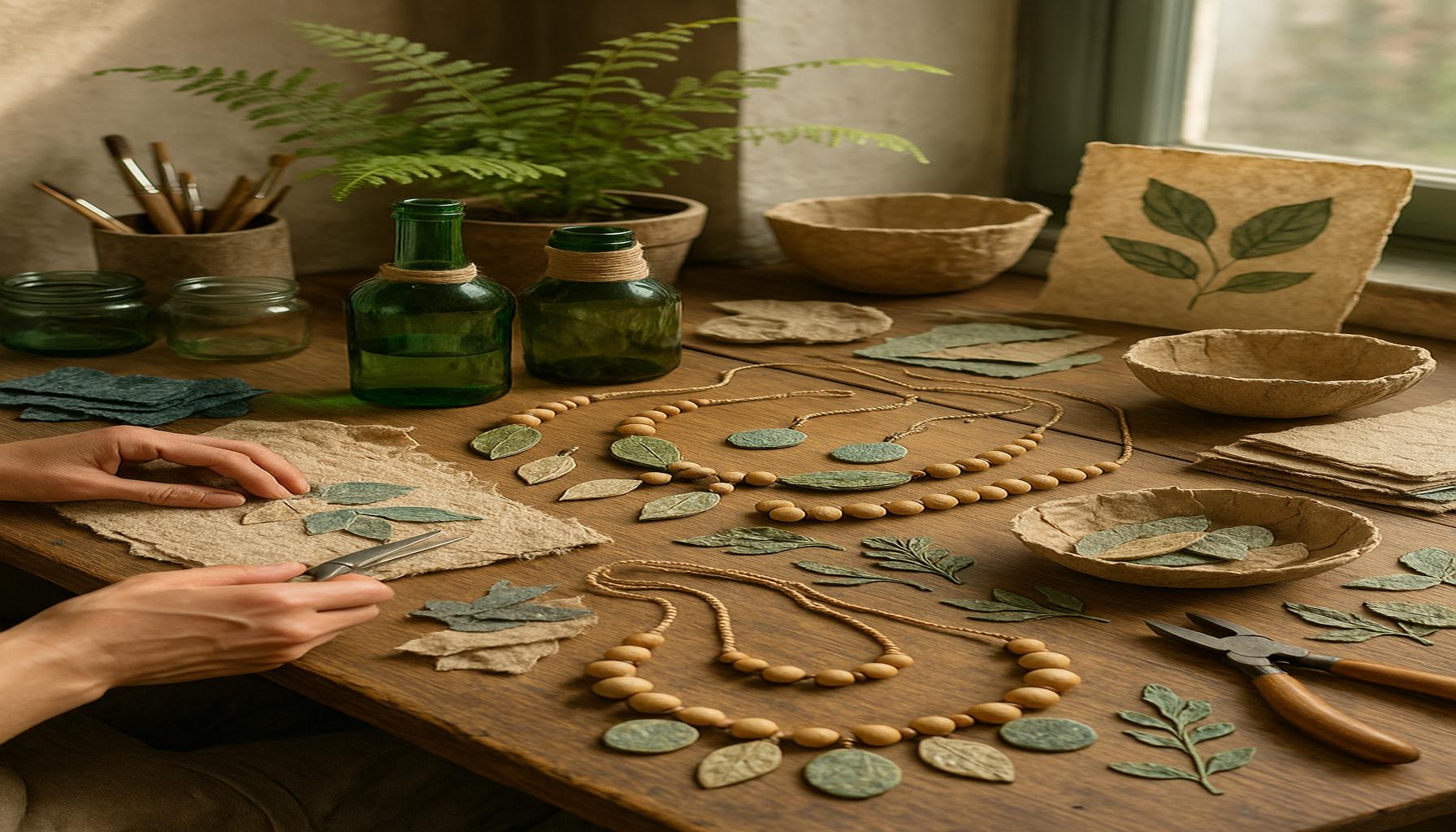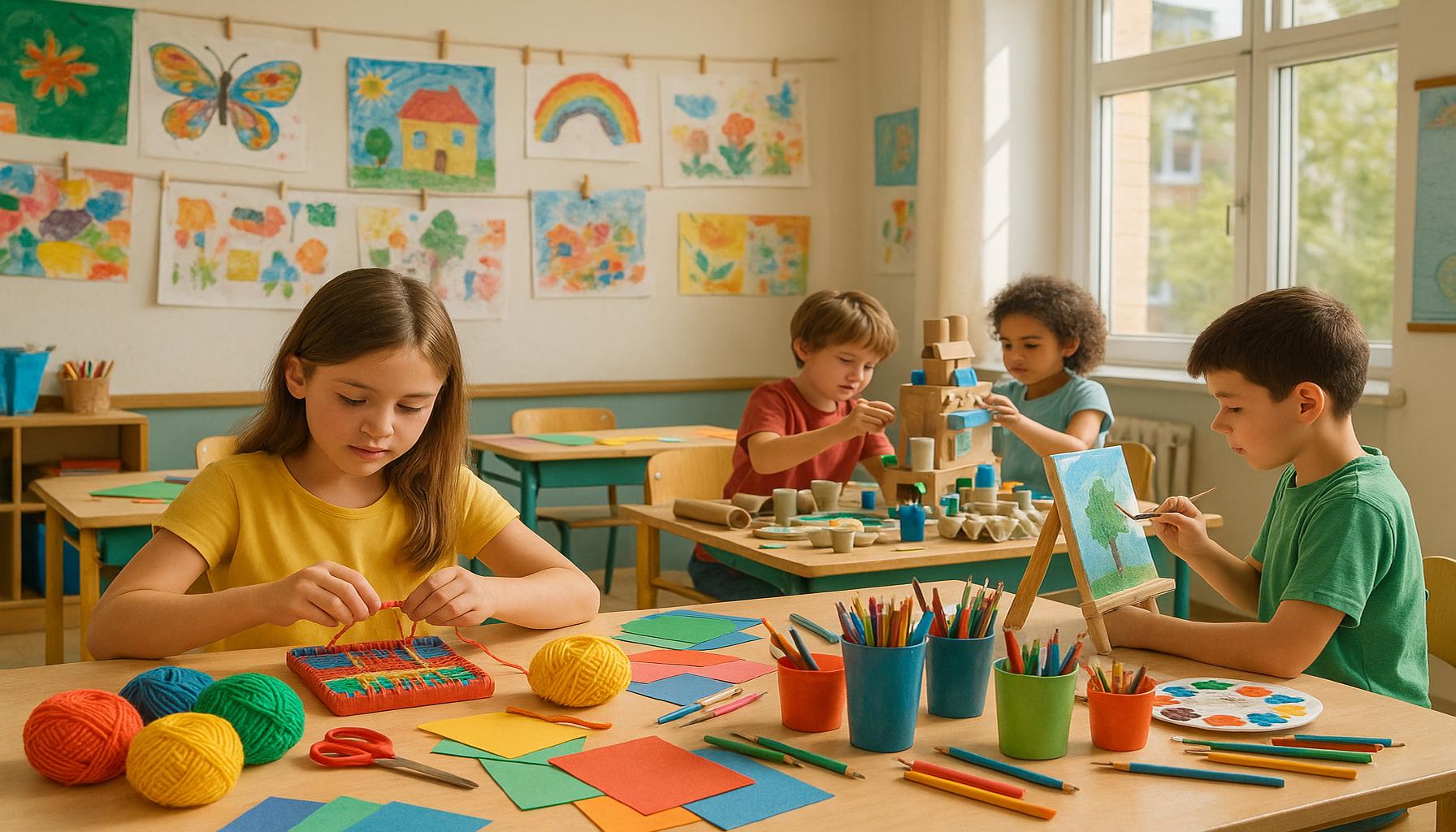The evolution of Crafting: From handmade to digital

The Evolution of Crafting Through the Ages
Crafting has uniquely woven itself into the fabric of human culture, continuously evolving from a necessity to an art form fueled by innovation. What began as a traditional practice rooted in techniques passed down through generations has now transcended into the realm of digital innovation. This journey of transformation can be intricately examined through several key phases of development.
- Handmade Crafting: Traditionally, crafting involved skills that were meticulously passed down within families or communities. Skills like weaving, pottery, and woodworking were honed over years, and these handmade items were often imbued with personal stories and cultural significance. For instance, Native American crafts reflect a rich history and heritage, often representing spiritual beliefs and traditions.
- Industrial Revolution: The advent of the Industrial Revolution in the 18th century marked a significant turning point in crafting history. The introduction of machinery allowed for mass production, which drastically reduced the time and cost involved in creating goods. While this increased availability led to a decline in handmade craftsmanship, it opened doors for new creative possibilities, leading to the birth of consumer culture.
- DIY Movement: Fast forward to the late 20th century, and the rise of the DIY (do-it-yourself) movement brought a resurgence of individual creativity. With the increasing commercialization of products, many began to appreciate the value of creating their own items. This period saw a boom in craft fairs, local workshops, and the proliferation of crafting books, encouraging even those without a background in art to explore their creativity.
- Digital Crafting: In the present day, the rise of the internet and digital tools has revolutionized crafting once again. Crafters now have access to sophisticated software that enables them to design and create with unprecedented precision. Digital cutting machines, 3D printers, and graphic design applications allow artisans to experiment and push the boundaries of traditional modalities, integrating technology with creativity seamlessly.
Consider the profound impact of platforms like Etsy, where the melding of handmade and high-tech provides a vibrant marketplace for artisans. A local potter can now sell their handcrafted pottery to someone across the globe, showcasing their work to an international audience. This accessibility has not only democratized the market but has also fostered a community where crafters can share tips, techniques, and inspiration.
As we further delve into this topic, the exploration of the intersection of creativity and technology reveals a dynamic landscape where craftsmanship is not just preserved, but continually reshaped. Each iteration of crafting, from handmade to digital, invites us to redefine our understanding of art, connection, and consumerism. The ongoing dialogue between traditional techniques and modern technology encourages us to appreciate the nuances of what it means to craft in today’s world, giving rise to new narratives and experiences that connect us all.
LEARN MORE: Click here to discover how music can enhance your well-being
From Traditional Skills to Modern Techniques
The lineage of crafting is deeply embedded in the mastery of traditional skills, where artisans dedicated countless hours to perfecting their crafts. Techniques truly varied from region to region, often utilizing local materials that imbued each piece with unique characteristics. For example, artisans in the American Southwest created intricate beadwork and textiles that celebrated their ancestry and the natural elements surrounding them. In contrast, artisans from New England became renowned for their exceptional woodworking skills, producing stunning furniture and decorative arts that mirrored their natural landscapes.

As society transitioned into the Industrial Revolution, these hands-on traditions faced significant disruption. The onset of mass production meant that consumers could obtain goods with efficiency never before imagined. Craftsmen found themselves navigating a complex relationship with machines; while the industrial age significantly reduced production time and costs, it also challenged the very essence of what crafting meant. The once-celebrated uniqueness of handcrafted items began to dilute, as factories pumped out uniform products, leading to a burgeoning consumer culture that prioritized convenience over individuality.
- Mass Production vs. Artisan Quality: The shift to industrial production resulted in a trade-off. While goods became more affordable, many consumers grew disillusioned by the lack of distinctiveness and artistry.
- Resurgence in Crafting: In response to industrialization, the late 20th century saw a revival of interest in handmade crafts. This period was characterized by a growing appreciation for local artisans and bespoke items, driven by consumers seeking a connection to their purchases.
- Community and Collaboration: The new wave of crafting emphasized collaboration within communities, where local workshops and craft fairs flourished, fostering an environment that nurtured creativity and artistic expression.
As we progressed further into the digital age, the accessibility of the internet began to breathe new life into the crafting sphere. Digital crafting represents a fascinating convergence of artistry and technology. Modern creators now harness advanced tools such as digital cutting machines and 3D printers, which enable infinite possibilities for innovation. Platforms like Etsy have changed the crafting landscape, allowing artisans to display their work to a global audience. A quilt maker in Georgia can easily share their techniques with a digital audience while selling unique designs directly from their workshop.
The blending of handmade traditions with cutting-edge technology not only transforms the way we craft but also our understanding of what it means to be a creator in the 21st century. As we unravel the implications of this evolution, it becomes essential to recognize that crafting is no longer confined to the physical realm. New digital platforms encourage a cross-pollination of ideas, allowing artisans to reach across the globe while upholding the cultural contexts of their craft.
The Transformation of Crafting in the Digital Age
As we delve into the fascinating journey of crafting from traditional handmade methods to contemporary digital practices, it becomes evident that this evolution has not only redefined the process but also expanded the horizons of creativity. Numerous artisans are now leveraging technology to enhance their skills and reach audiences far and wide. This remarkable shift underscores the importance of adapting to modern tools while maintaining the essence of craftsmanship.The rise of digital platforms has democratized crafting, giving access to a global marketplace that was once limited to local communities. Through websites, social media, and online marketplaces, crafters can showcase their unique creations, making it possible for them to tap into diverse audiences and generate income. This transition highlights how traditional skills can seamlessly mesh with technological innovations, creating new opportunities for growth and collaboration among artisans.One of the most significant advancements is the integration of 3D printing technology. This innovation allows crafters to produce intricate designs with precision, opening up a realm of possibilities that were previously unimaginable. Artisans can now experiment with materials and creations on a scale that promotes both individual expression and business expansion.Furthermore, the digital crafting community fosters collaboration and sharing of knowledge through online forums and workshops. This collective effort amplifies the learning experience, allowing crafters to refine their skills, share tips, and inspire one another. As a result, the traditional art of crafting is blossoming into a thriving digital ecosystem, where innovation is celebrated, and creativity knows no bounds.In summary, the evolution from handmade to digital is not merely a change in method but a profound transformation that nurtures artistic growth and enables crafters to explore new dimensions in their work. As this trend continues to unfold, it will be intriguing to watch how the crafting landscape evolves, inviting enthusiasts of all skill levels to partake in this captivating journey.
| Category | Advantages |
|---|---|
| Access to Global Market | Expanded reach for artisans to sell their creations beyond local borders. |
| Innovation Through Technology | Creative experimentation with tools like 3D printing enhances craftsmanship. |
DISCOVER MORE: Click here to learn about the evolution of digital art
The Democratization of Crafting Through Technology
As the digital landscape has evolved, so too has the world of crafting, enabling a new wave of creators to emerge. The accessibility of technology has democratized the crafting process, allowing individuals from varied backgrounds to engage in and experiment with creative endeavors. Online tutorials and platforms such as YouTube and Pinterest have inspired countless newcomers to explore their artistic potential. By simply clicking a button, a novice can gain insights into complex techniques previously exclusive to skilled artisans, creating a fertile ground for innovation.
A significant aspect of this digital crafting evolution is the impact of social media. Platforms such as Instagram and TikTok have become essential tools for artisans to showcase their work, attract followers, and inspire others. Hashtags like #CraftingCommunity and #HandmadeWithLove create connections between individuals with shared interests, fostering a global network of creators and appreciators. Notably, the rise of influencers in the crafting space has given individuals direct access to creative content and ideas, further amplifying the crafting movement in new and exciting directions.
Emerging Technologies and Crafting Innovations
The technological advancements that have permeated the crafting world have led to a remarkable fusion of traditional techniques and modern tools. For instance, laser engraving and 3D printing allow artisans to maintain intricate details while optimizing production efficiency. The application of these technologies has revolutionized how crafting items are produced, giving rise to complex designs that traditional methods could seldom achieve. A craftsman who specializes in jewelry, for example, can utilize 3D modeling software to experiment with forms that push the boundaries of conventional artistry.
Furthermore, the advent of digital patterns has simplified the creation process for many traditional crafts. Quilting, knitting, and sewing have experienced a renaissance due to downloadable materials that streamline crafting projects. Resources like Craftsy and Ravelry offer forums for sharing patterns, techniques, and insights, creating avenues for collaboration and skill-sharing among enthusiasts. These platforms empower creators to explore diverse approaches to familiar crafts, kindling a spirit of innovation grounded in tradition.
The Entrepreneurial Spirit of the Digital Crafter
With the rise of the digital landscape, crafting has transcended mere hobbyism into a viable entrepreneurial avenue for many. Artisans can sell their creations on various online marketplaces, effectively competing in a global marketplace. Platforms like Etsy and Society6 have opened the door for micro-businesses to flourish, allowing crafters to monetize their skills and reach target markets previously deemed unattainable. The modern craftsman can now operate from a home studio, turning passion into profit.
Data from the 2021 Small Business Administration report indicates that handmade goods shops have surged, with an estimated 4.2 million Americans engaged in crafting-related businesses. This entrepreneurial boom not only reflects the love of crafting but also the accountability of the consumer to support artisans, thereby fostering sustainable practices that root themselves in local communities.
As artisans navigate this evolving landscape, they encounter both opportunities and challenges. Issues such as ensuring quality in mass-produced items, pricing fairly for handmade products, and standing out in a crowded marketplace require continuous adaptability. Nonetheless, as the boundaries between handmade and digital continue to blur, the spirit of crafting perseveres, championing individuality and creativity as essential elements of the human experience. The journey from traditional skills to digital innovation sets the stage for a crafting renaissance unlike any seen before.
DIVE DEEPER: Click here to learn more about the psychological benefits of artistic hobbies
Conclusion: Crafting in a Digital Age
The evolution of crafting, from its traditional roots to the innovative digital realm, marks a transformative period in the creative landscape. As we’ve explored, the integration of technology has significantly reshaped how artisans express their creativity, communicate their work, and build communities around shared interests. The accessibility of online resources and platforms has not only empowered a new generation of crafters but also blended traditional techniques with modern advancements, paving the way for unprecedented artistic exploration.
Moreover, the entrepreneurial spirit among digital crafters suggests a promising shift toward supporting local artisans and sustainable practices. As highlighted, an estimated 4.2 million Americans are now involved in crafting-related businesses, demonstrating the growing inclination to turn passion into profit. This shift underscores the importance of adaptability and quality assurance in a market where handmade items coexist with mass-produced goods.
As we look ahead, the future of crafting holds infinite potential. Emerging technologies such as augmented reality and advanced manufacturing tools could redefine the crafting experience, further blurring the lines between physical and digital art. Consumers and creators alike will need to navigate this rapidly changing terrain with an eye toward innovation and sustainability.
Ultimately, the journey from handmade to digital crafting encapsulates not only a change in techniques but also a celebration of creativity’s enduring power. It invites us to embrace the multitude of ways we can create, share, and connect in an ever-evolving landscape, heralding a crafting renaissance that honors both tradition and progress.


